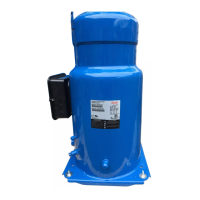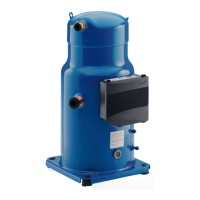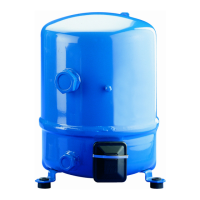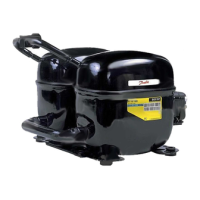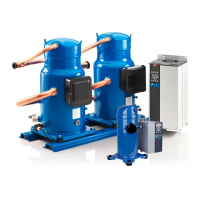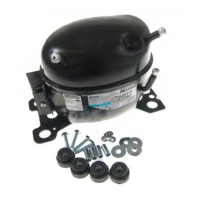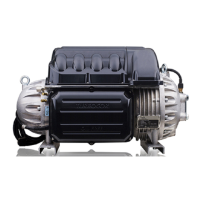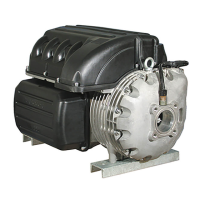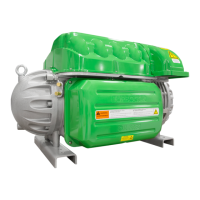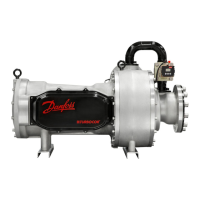APPLICATION GUIDELINES
FRCC.PC.007.B5.02
31
SYSTEM DESIGN RECOMMENDATIONS
A LLSV may be used to isolate the liquid charge
on the condenser side, thereby preventing
against charge transfer or excessive migration to
the compressor during off -cycles. The quantity of
refrigerant on the low-pressure side of the system
can be further reduced by using a pump-down
cycle in association with the LLSV.
Liquid line solenoid valve
(LLSV)
Pump-down cycle A pump-down cycle represents one of the most
eff ective ways to protect against the off -cycle mi-
gration of liquid refrigerant. Once the system has
reached its set point and is about to shut off , the
LLSV on the condenser outlet closes. The com-
pressor then pumps the majority of the refriger-
ant charge into the condenser and receiver before
the system stops on the low pressure pump-down
switch. This step reduces the amount of charge
on the low side in order to prevent off -cycle mi-
gration. The recommended low-pressure pump-
down switch setting is 1.5 bar below the nominal
evaporating pressure. It shall not be set lower than
2.3 bar(g). For suggested wiring diagrams, please
see section "Suggested wiring diagrams logic".
In certain conditions, the discharge valve in the
SH090 - 105 - 120 - 140 - 161 - 180 - 184 compressor
may not completely seal and result in compres-
sor restarts during pump down applications. An
external, non-bleeding check valve may need to
be installed.
Tests for pump down cycle approval:
As the pump-down switch setting is inside the •
application envelope, tests should be carried
out to check unexpected cut-out during tran-
sient conditions (ie. defrost – cold starting).
When unwanted cut-outs occur, the low pres-
sure pump-down switch can be delayed. In this
case a low pressure safety switch without any
delay timer is mandatory.
Sump heater The surface sump heaters are designed to protect
the compressor against off -cycle migration of
refrigerant.
When the compressor is idle, the oil temperature
in the sump of the compressor must be main-
tained at no lower than 10 K above the satura-
tion temperature of the refrigerant on the low-
pressure side. This requirement ensures that
the liquid refrigerant is not accumulating in the
sump. A sump heater is only eff ective if capable
of sustaining this level of temperature diff erence.
Tests must be conducted to ensure that the ap-
propriate oil temperature is maintained under
all ambient conditions (temperature and wind).
Note that below –5°C ambient temperature and a
wind speed of above 5m/second, we recommend
that the heaters be thermally insulated in order to
limit the surrounding energy losses.
Since the total system charge may be undefi ned,
a sump heater is recommended on all stand-
alone compressors and split systems. In addi-
tion, any system containing a refrigerant charge
in excess of the maximum recommended system
charge for compressors requires a sump heater. A
sump heater is also required on all reversible cycle
applications.
SH090-105-120-140-161-184 initial start-up: Due
to light commercial platform compact design, it
is recommended to energize surface sump heater
in advance to remove refrigerant at initial start-up
only 6 hours in advance.
SH180-240-300-380 initial start-up: For large
commercial platform initial start-up, it is not rec-
ommended to energize the crankcase heater in
advance, but quick starts may be needed to evac-
uate refrigerant in the system.
Then the heater must be energized whenever the
compressor is off to avoid liquid refrigerant enter-
ing the compressor.
Provide separate electrical supply for the heaters
so that they remain energized even when the ma-
chine is out of service (eg. Seasonal shutdown).
Surface sump heater accessories are available
from Danfoss (see section "Accessories").
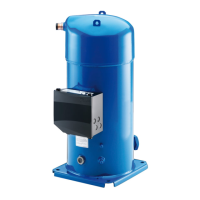
